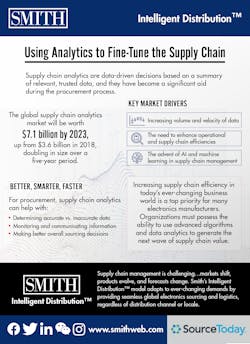The ability to make data-driven decisions based on a summary of relevant, trusted data, supply chain analytics have become a hot topic for organizations over the last few years. Between the proliferation of data and the crop of new technology tools that help companies harness and use that information, the push to infuse more supply chain analytics into the procurement process has increased significantly.
“Supply chains are a rich place to look for competitive advantage, partly because of their complexity, and partly because of the significant role they play in a company’s cost structure,” Deloitte points out. “And with the power of new analytics, companies can now fine-tune their supply chains in ways that simply weren’t possible in the past.”
For example, Deloitte says good supply chain analytics help organizations:
- Use historical enterprise data to feed predictive models that support more informed decisions
- Identify hidden inefficiencies to capture greater cost savings
- Use risk modeling to conduct “pre-mortems” around significant investments and decisions
- Link supply chain models to customer and pricing analytics to clarify the whole profitability picture, not just the parts and pieces
Companies across all industries are utilizing supply chain analytics to achieve these and other “wins”. According to MarketsandMarkets, the global supply chain analytics market will be worth $7.1 billion by 2023, up from $3.6 billion in 2018. This doubling in size over a five-year period proves just how valuable analytics have become for organizations of all sizes.
Key Market Drivers
The research firm says that the key factors driving this market include the increasing volume and velocity of data; the need to enhance operational and supply chain efficiencies; and the advent of artificial intelligence (AI) and machine learning in supply chain management. It singles out inventory analytics as a primary focal point for many companies right now, noting that this sector of the market claimed the largest chunk of the supply chain analytics market in 2018.
Concerned about inventory levels, these organizations are leaning toward inventory analytics solutions that help them determine the minimum inventory targets across the entire supply chain network. “The inventory analytics software enables organizations to monitor inventory levels to enhance sales performance, improve cost exposure, maintain optimum inventory, and increase turnover through inventory level reduction,” MarketsandMarkets points out in a press release.
In a different report on supply chain analytics growth, MarketsandResearch says the sector is on track to grow by 14.1% (compounded annual growth rate or CAGR) over the next six years. It notes that use of analytics in planning and procurement will actually exceed that growth rate, and particularly for applications that allow companies to keep abreast of the changing pulse of the market.
Better, Smarter, Faster
For procurement, supply chain analytics can help with establishing trusted sources of information (e.g., determining accurate vs. inaccurate data); monitoring and communicating information; identifying red flags well in advance; taking corrective actions on those issues; and making good overall decisions, Transplace’s Matt Harding writes in Logistics Viewpoints.
As the studies show, more companies are buying into the idea that supply chain analytics can help them work better, smarter, and faster in a competitive business environment. This trend is likely to continue as even more organizations catch onto the value of good analytics.
“Driving operational growth and increasing supply chain efficiency in today’s ever-changing business world is a top priority for many companies,” Harding writes. “In order to grow in a rapidly evolving marketplace, organizations must possess the ability to use advanced algorithms and data analytics to generate the next wave of supply chain value.”











